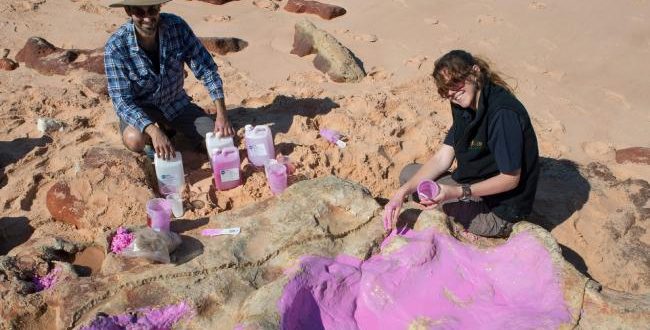Scientists have found signs of ancient dinosaur fossils from the Cretaceous Period in Australia. Actually Australia’s Jurassic Park is world’s most diverse site of dinosaur tracks.
A team of palaeontologists identified 21 different types of dinosaur tracks on a 25km stretch of coastline north of Broome, in the remote Kimberley region in the north of Western Australia.
Sauropod (long-necked, long-tailed dinosaur) prints up to a whopping 1.7 metres were among those found in the region
According to the Telegraph, Dr Steve Salisbury, the lead author of the study and a palaeontologist at the University of Queensland, said: “Nowhere else has as many different types of dinosaurs represented by tracks than Walmadany [James Price Point] has.
“It’s such a magical place, Australia’s own Jurassic Park, in a spectacular wilderness setting.”
According to the Sydney Morning Herald, Dr Salisbury said: “Twenty-one different types of dinosaurs all living together at the same time in the same area. We have never seen this level of diversity before, anywhere in the world. It’s the Cretaceous equivalent of the Serengeti. And it’s written in stone.”
And the BBC reports that he added: “This is the most diverse dinosaur track fauna we’ve ever recorded.
“In this time slice (127 and 140 million years ago) in Australia, we’ve got no other record – there’s virtually no other fossils from any part of the continent. This is the only window, and what we see is truly amazing.
“Twenty-one different types. There are about six different types of tracks for meat-eating dinosaurs; about the same number for sauropod dinosaurs; about four different types of ornithopod dinosaur tracks – so, two-legged plant-eaters – and really exciting, I think, are six types of armoured dinosaur tracks, including stegosaurs, which we’ve never seen before in Australia.”
Dr Salisbury explained that a footprint measuring 1.7 metres would likely have belonged to an animal that was “probably around 5.3 to 5.5 metres at the hip, which is enormous.”
He shared some of his findings on Twitter.
Sauropod dinosaur tracks from the Walmadany area, WA, and their potential trackmakers. #DinosaurCoast #UQ https://t.co/B3NAlwBreD pic.twitter.com/ThYZuSrNYo
— Steve Salisbury (@implexidens) March 27, 2017
The Walmadany area is home to the world's largest dinosaur tracks. Law Boss Richard Hunter and a 1.7m sauropod track https://t.co/B3NAlwBreD pic.twitter.com/X2Ii5GiC7u
— Steve Salisbury (@implexidens) March 27, 2017
The research was carried out by palaeontologists from The University of Queensland’s School of Biological Sciences and James Cook University’s School of Earth and Environmental Sciences, and has been published as the 2016 Memoir of the Society of Vertebrate Palaeontology.
Agencies/Canadajournal
 Canada Journal – News of the World Articles and videos to bring you the biggest Canadian news stories from across the country every day
Canada Journal – News of the World Articles and videos to bring you the biggest Canadian news stories from across the country every day



